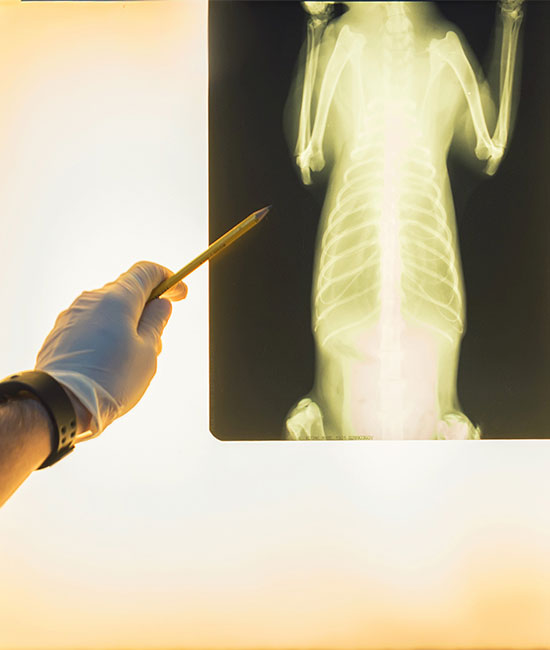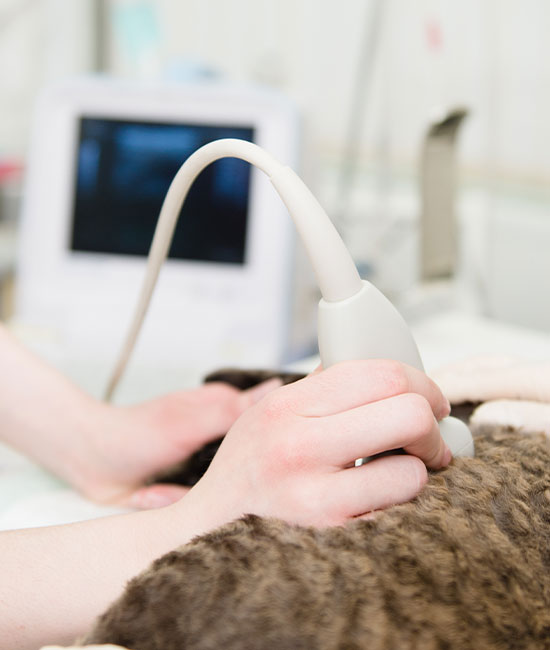Digital Radiography (X-Rays)

Radiology is a non-painful, non-invasive diagnostic tool that can be extremely useful
when dealing with sick or injured animals. Our in-house pet imaging equipment allows us to quickly evaluate your pet to help determine the cause of his or her individual problem. In a matter of minutes, we are able to diagnose numerous conditions and disease processes such as:
We have twice weekly rounds with a board certified radiologist to ensure our veterinarians make the most accurate diagnosis and treatment plan for your pet.
+-
- Gastrointestinal foreign object obstructions
- Fractures
- Hip or Elbow Dysplasia
- Developmental abnormalities
- Neoplastic processes or cancer
- Pregnancy
- Heart Failure
- Pneumonia
- Abdominal Cavity Infections
- Megaesophagus
Veterinary Ultrasound

Every 2 weeks Memorial Villages has a board-certified radiologist that performs
ultrasounds and echocardiograms. This non-invasive, state-of-the-art technology uses sound waves to painlessly examine specific internal organs, primarily the heart and abdominal organs. We also have the capability for ultrasound-guided fine needle aspirates; biopsies; thoracocentesis; abdominocentesis and cystocentesis. Pregnancy exams are also available. With veterinary ultrasound, we can diagnose many animal diseases such as:
+-
- Neoplasia or cancer
- Cushings Disease
- Heart Failure
- Pleural effusion
- Abdominal effusion
- Lung torsion
- Foreign objects
- Cholangiohepatitis
- Portosystemic Shunts
Dental X-Rays

Veterinary intraoral radiographs, or Dental X-Rays, are the best way to image a dog or
cat’s teeth and most areas of the jaw bones. These dental radiographs are the same as what you would have taken when you are at the dentist. The dental film / radiographic sensor is placed in the mouth and then an image can be obtained. Since the film/sensor has to be placed in the mouth and the patient must be very still, intra-oral radiographs for pets must be obtained under general anesthesia.
Without dental radiographs a full assessment of the health of your pet’s teeth cannot be completed. More than 50 percent of a dog or cat tooth’s surface area (tooth root) is below the gum line and is therefore not visible to the naked eye. This is where veterinary dental radiographs come in and provide the veterinary dentist the following information about a pet’s dental condition:
As part of a “complete oral exam”, full mouth radiographs are performed for all of our patients.
+-
Without dental radiographs a full assessment of the health of your pet’s teeth cannot be completed. More than 50 percent of a dog or cat tooth’s surface area (tooth root) is below the gum line and is therefore not visible to the naked eye. This is where veterinary dental radiographs come in and provide the veterinary dentist the following information about a pet’s dental condition:
- Often radiographs can identify dental disease processes that effect primarily or only the root and it’s supporting bone. Important pathology can be present that is not apparent from the oral exam.
- Intra-oral Radiographs are essential for monitoring the progress of many previous dental and oral surgical procedures.



